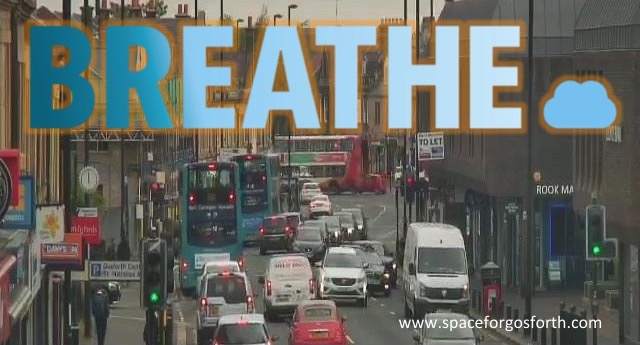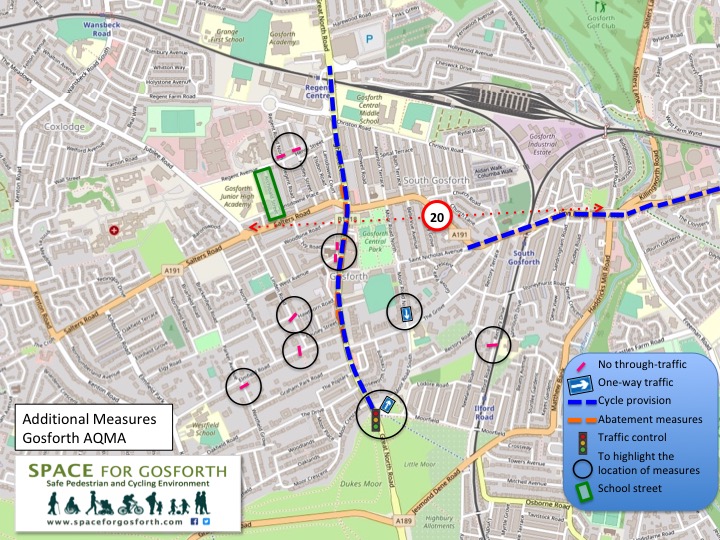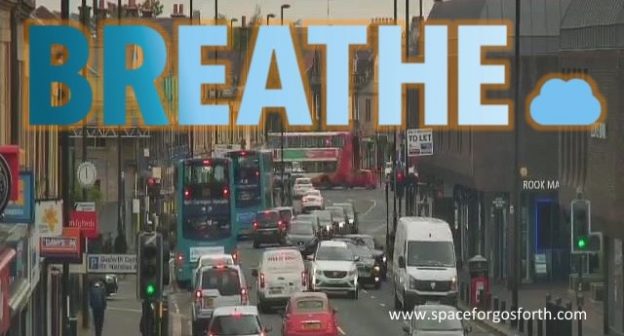
This is the third of four SPACE for Gosforth blogs that together make up our response to the Council’s Clean Air consultation.
Our first blog set out our review of the Council’s proposed measures. In our second blog we proposed measures for the city as a whole and specifically for the City Centre Air Quality Management Area (AQMA).
In this blog we propose specific measures for the Gosforth Air Quality Management Area (AQMA) which covers Gosforth High Street, Jesmond Dene Road, Haddricks Mill Road and the Haddricks Mill junction.
Some of the measures described in our second blog for the city as a whole will also reduce air pollution in Gosforth, though we don’t believe these will be sufficient by themselves to meet air quality limits. These include:
- Retrofitting bus engines so they are EURO VI compliant.
- A clean air zone for buses, coaches, taxis and HGVs covering the area between the Tyne in the south and the Metro line in the north.
- High frequency bus route branding, including for Gosforth High Street / the Great North Road.
- Public information and better enforcement of anti-idling laws.
To ensure that limits are met in the shortest possible timescales and exposure is reduced as quickly as possible (the legal requirement) we are proposing further measures specific to Gosforth. To do this we have looked at options that have been shown to reduce pollution and reduce people’s exposure to pollution, as well as providing for better walking and cycling access to the Gosforth High Street shops.
As we said in our review of the Council’s proposals, we do not believe the proposals as presented meet the legal requirement to meet air quality limits and reduce exposure as quickly as possible. The Council has since presented some revised options which delay implementation even further and look even less likely to meet the legal requirement.
As before we have prioritised, where possible, engineering measures rather than charging. Some sort of clean air charge for private vehicles is the most likely alternative to these proposals in Gosforth if these are not accepted.
SPACE for Gosforth response to the Council’s Clean Air consultation: Part 3
Additional measures for the Gosforth AQMA
Air quality exceedances in Gosforth have been limited to Gosforth High Street, Station Road and Killingworth Road, although Station Road and Killingworth Road were under the limit in the second half of 2017 after Killingworth Road closed for road works. Clearly there is a risk now Killingworth Road is due to re-open to traffic that those locations will be over the limit again.
That means we need measures to address air pollution at both locations.

Figure 5 – SPACE for Gosforth proposals for the Gosforth AQMA
As a priority we are asking the Council to revisit its plans for Haddricks Mill, which will encourage additional traffic in the Gosforth / North Newcastle area and provide a poor experience for people walking and cycling. The Government’s UK Air Quality Plan states that there is considerable uncertainty on the real world impacts of measures that ‘optimise traffic flow’. Potentially the current Haddricks Mill plans could increase pollution levels, which is entirely inconsistent with the Council’s legal obligation to reduce air pollution in the shortest possible timescales. Haddricks Mill is a key east-west route for all forms of transport. In light of the need to address air quality, walking, cycling and public transport all need to be prioritised at this location.
For Gosforth High Street we understand the Council’s expectation to be that there will be a knock on benefit from reduced traffic on the Tyne bridges. That may be the case, but there are also plenty of local journeys made that do not cross the Tyne that could quickly use up this extra capacity. To address this we suggest:
- Re-paint Gosforth High Street to be one lane in each direction. This also means traffic can be moved away from the pavement to reduce exposure.
- Use the available space next to the pavements for protected cycle lanes to give an additional option for people to travel to the shops without using their cars.
- At peak times, limit traffic entering the High Street from the south, using traffic lights in a similar manner to that proposed at Haddricks Mill. These lights can also be used to allow buses through.
- Mitigations on parallel residential streets so they are not used to bypass the above measures.
- Expand Trinity Square north and south to use the space no longer used by traffic.
- School streets to help reduce school-run traffic.
- Regular Clean-Air days on Gosforth High Street.
- Reviewing and updating parking charges so it is cheaper to park and ride at the northern edge of Newcastle rather than driving into the city or parking e.g. near Ilford Road or South Gosforth Metro stations.
These measures are described further below.
C01 Urgently revisit the plans for Haddricks Mill to remove the risk of induced traffic and create space for separate walking and cycling facilities. Consider if other mitigation measures are also required, to offset the impact of increased traffic levels once Killingworth Road re-opens to two-way traffic. By 06/2019
C02 Re-line Gosforth High Street up to Regent Centre as a single lane in each direction sited in the middle of the current carriageway to reduce exposure by moving traffic away from the pavement. By 08/2019
C03 Use the space created by (C02) to implement a protected cycle lane so people can travel to the shops and services on Gosforth High Street without using a car. Initially, for speed of implementation, these can be completed with temporary ‘bolt-down’ kerbs to give protection from traffic. Gosforth High Street 10/2019
C04 Change the timings on pedestrian crossings to be more responsive to reduce exposure for people waiting to cross. By 10/2019
C05 Install hedges as barriers where space exists e.g. on Trinity Square / outside Gosforth shopping centre. By 10/2019
C06 Clean Air Saturdays – once a month, close Gosforth High Street between St Nicholas Avenue and Church Road to all traffic except buses. By 10/2019
C07 Reconsider the location of bus stops so they still provide good access to the shops but passengers do not have to wait in the most polluted areas. Also ensure that bus stops are fit for purpose and provide weather protection for waiting passengers. By 01/2020
C08 Use traffic lights at the south end of Gosforth High Street next to the Town Moor to control traffic levels entering the High Street during peak hours, similar to the Council’s Haddricks Mill proposal. Initially, for speed of implementation this might require some manual control. By 01/2020
C09 Make changes to the following roads to prevent through traffic using them as an alternative to the High Street to avoid measure C08: Linden, Moor Road North and South, Ilford Road, Regent Road North/Hedley terrace, Westfield Grove, West Avenue, Ivy Road. The ends of West Avenue and Ivy Road could be combined with Trinity Square to create a much larger public event space. The specific locations have been chosen as far as possible to minimise additional journey time for residents living in those neighbourhoods. By 01/2020
C10 Enable and fund local schools in Gosforth and the north of the city to implement school streets where streets next to schools are closed to through traffic during drop off and pick up times. By 01/2020
C11 Review of parking and parking charges so that when entering by car from the north of the city it is cheapest to park and ride from Great Park, and more expensive to park closer to the city centre. Currently it is cheaper and quicker to park near Ilford Road Metro than to use the Great Park or Regent Centre park and ride facilities. By 01/2020 (Review implemented)
C12 Implement 20mph from the Gosforth Traders roundabout at the south end of Jubilee Road to Haddricks Mill roundabout. By 02/2020
C13 Install traffic-free cycle lanes on Station Road between Saint Nicholas Avenue and Haddricks Mill roundabout. This may need to divert from the main road at the final stretch approaching the roundabout due to lane width. By 03/2020
C14 Install traffic-free cycle lanes on Benton Park Road between Haddricks Mill roundabout and St Mary’s Catholic School and the Benton Park View government site. Initially, for speed of implementation, these can be completed with temporary ‘bolt-down’ kerbs to give protection from traffic. By 03/2020


I welcome these measures but would ask that traffic on streets where schools are located be further limited as the volume of traffic increase during school term time is such that it has a huge negative impact on the quality of life for residents on these streets. According to the parking times notices all the people who park their cars here after 3 pm are breaking the law. This should be better enforced to discourage people from driving to pick up /drop off their children. The difference between living on Archibald Street during the school holidays and term time is polar opposites. I have lived here for 15 years and it is worse now than it ever was.
Many thanks for all your work in responding to the Council’s consultation. I just wanted to mention a few points re your High Street proposal to reduce traffic to a single lane in each direction and provide a cycle lane in the freed up space next to pavement. Firstly I’m not sure how this would work as buses would need to stop directly adjacent to the pavement when picking up and dropping off passengers. Secondly, as a cyclist I would still prefer the designated cycle route of Moor Road North, Moor Road South/Alwinton Terrace because it is safe, convenient and relatively traffic-free. Thirdly the High Street is intrinsically dangerous for cyclists because of the number of vehicles turning into, and out of, side streets whose drivers often do not see passing cyclists on the High Street because of queuing traffic. This fundamental problem will not be resolved so I suggest it is much better to park bikes at adjacent areas then walk to shops. If the proposal to reduce to one traffic lane each way is taken forward I suggest it would be preferable to use the freed up space for Street trees/hedgerow planting and more space for pedestrians.
Hi Julie, thanks for the detail feedback. If these idea are pursued then absolutely the issues you mention will need addressing.
We have looked at the High Street and are confident that there is space for traffic, bus stops, protected cycle lanes, additional greenery and additional space for people on foot.
There are well proven methods for how to mix all these elements safely, including danger from turning vehicles. Our previous post ‘Pedestrian Priority on Gosforth High Street’ included some of these ideas.
I agree with the comments from Julie and overall I agree with the measures SFG are suggesting however I think protected cycle lanes could bring negatives to Gosforth High Street if not implemented right. It is a destination and community more than other parts of the GNR and therefore the priority in this core area should be more on walking, services and shopping, not passing through. The heritage and functionality of the street, not too mention the residential houses which exist along it, mean that creating more “no go” lanes on each/ one side will only divide the East from the West side. “Temporary” bolt down kerbs are an eye sore and could exist for many years until the Council takes action- these would prevent deliveries and access to property. Emergency service vehicles, delivery wagons and breakdowns would stop the traffic altogether. I appreciate turning vehicles can be dealt with by certain measures.
Any proposal here needs carefully thought through, so we dont end up with more peace-meal measures which satisfy no one.
As I understand it, 20mph zones even without enforcement, do bring the mean speed of traffic down- so I can’t wait for these to come in, although go easy on the signage please NCC
Hi Rob,
The article above is in response to the Council’s air quality consultation where the legal requirement is to ensure air quality limits are met in the shortest possible timescales. That legal duty outweighs any aesthetic considerations as poor air quality is a serious and immediate health threat, especially to residents who live on the High Street.
That said, we would absolutely support a high quality scheme that allows people of all ages and abilities to walk or cycle to the HIgh Street shops so that, unlike now, there are no ‘no go’ zones as you suggest.
None of this would prevent access to properties, access by emergency services or local deliveries, all of which are essential to the operation of the High Street. The greatest impediment to emergency services is vehicle traffic.
Overall, the proposals in relation to single lane demarcation, bus stops, etc are good, but I’m not sure that any speed limits, let alone 20 mph ones work unless there is enforcement through measures like speed cameras at junctions such as the one at Church Road / High Street.
Some buses are already hybrids, but they need to be obliged to use electric only between the centre of town and Regent Centre or Haddricks Mill, with grants to convert all buses to dual fuel by 2025.